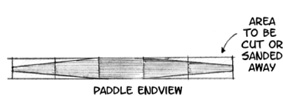

A good canoe paddle can set you back big bucks, but a person in a hurry can make one for nothing. Just cut off the end of a broken goalie stick — you’ll have a funky paddle about 3 1/2" wide. Make two, join the shafts with duct tape or screws, and you’ve got a kayak paddle. If you’re not in a hurry, though, you can make a nice one that will cost you nothing but a lot of sweat, some glue, and a friend with the appropriate tools.
The shape and dimensions of paddles are as varied as the … as the … well, the simile escapes me now, but there are a heck of a lot of styles. How do you select the one that’s best for you? Go to your local boat shop and chat up the salesman. Act enthusiastic. Request a catalogue with photographs of the models available, and bada bing! Go home, carefully copy the shape you’ve selected, and make a pattern out of cardboard.
All paddles have the same general properties: a centre stick the length of the paddle, flanked by two pieces of stick on each side for the blade. These five pieces, joined side to side, will make a paddle about 6" wide. Determine your personal paddle length by holding your arms out at your sides and measuring palm to palm. The length of the blade depends on the paddle style, but a standard blade length would be 20". A paddle blade is usually thicker at the centre and tapers to about 1/4" at the edges.

Make friends with someone who has a joiner and band saw. The joiner will shave the sides very smooth for gluing, and the band saw will be handy for shaping the blade profile to save sanding time and effort. Glue the paddle pieces together with a waterproof glue or epoxy. Clamp tightly and let dry thoroughly. Use a belt sander to smooth out the blade and get it close to the final shape. Going from coarse to fine grit, sand the blade to as smooth a finish as possible.

To make the blade stronger and more durable, put on a layer of fibre-glass cloth using epoxy resin and hardener. Marine resins make a nice finish on a paddle. This stuff is toxic, so follow instructions carefully. Sand the shaft and top handle perfectly smooth. The time you spend now making the handle fit comfortably will pay off handsomely later in smooth, blister-free strokes. If you refrain from paddle abuse, you will save yourself many hours of thinking, “Why didn’t I just buy a stinking paddle in the first place?”